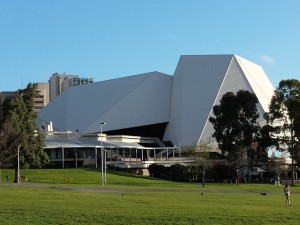 Do you remember a time when Adelaide’s Festival Theatre didn’t exist? Do you remember the City Baths that once stood in its place? This episode, we take a look back at the development of the Festival Theatre (and the adjoining plaza) and celebrate the architect responsible for the Theatre’s inside-to-outside design.
Do you remember a time when Adelaide’s Festival Theatre didn’t exist? Do you remember the City Baths that once stood in its place? This episode, we take a look back at the development of the Festival Theatre (and the adjoining plaza) and celebrate the architect responsible for the Theatre’s inside-to-outside design.
Festival Theatre Facts
- opened 2 June 1973
- the first multi-purpose arts centre constructed in Australia
- developed to accommodate Adelaide’s burgeoning Festival of Arts
- Premier Steele Hall selected the riverside site, setting the location for the cultural heart of the city
- the government of the day changed, and new Premier Don Dunstan (with Lord Mayor Robert Porter) launched a public appeal to fund the new development – the initial target was met in a week!
- surplus funds were set aside to create a world-class collection of artworks to be exhibited at the Theatre
- the existing City Baths were demolished to make way for the new development
- construction finally started in 1970
- the government printing building made way for the plaza adjoining the Festival Centre
- the builder was Victorian company AV Jennings
- the Theatre is set on a 45º angle to the city grid
- there were no budget blowouts or time delays
- the Theatre cost $10,000,000
- the entire complex cost $21,000,000
- by contrast, the Sydney Opera House cost $102,000,000 and suffered numerous budget blowouts since building commenced in 1959
- Festival Theatre was opened by Prime Minister Gough Whitlam, 3 months before the Sydney Opera House
- the Playhouse (now Dunstan Playhouse), Space Theatre and Amphitheatre followed on from the building of the Festival Theatre, the completed Centre being unveiled by 1980
- John Morphett was the designer of the Festival Theatre
- he created the building from the inside-out, keeping in mind the technicians behind the scenes, the performers on-stage and the audience
- he is also credited as the architect for many other South Australian buildings and public spaces, including:
- Flinders University
- Stock Exchange Plaza
- Monarto city centre
- Rundle Street car park
- Gilles Plains Community College
- Samuel Way Law Courts
- Colonel Light Centre
- Noarlunga Shopping Centre
- Performing Arts Centres of Mt Gambier, Port Pirie, and Whyalla
- Leigh Creek South Town Centre
- Amy Wheaton Building at the University of South Australia’s Magill campus
- Adelaide Entertainment Centre
- Bradman Stand at Adelaide Oval
Quick Facts
- the complete Festival Centre has two physical locations:
- riverside on King William Road, adjacent to Elder Park
- Her Majesty’s Theatre on Grote Street
- the Festival Theatre seats close to 2,000 people
- designed as both a lyric theatre and concert hall
- houses the Silver Jubilee Organ, a ‘hovering’ pipe organ built and donated to mark the Silver Jubilee of Queen Elizabeth II
- the Dunstan Playhouse seats 620 people on two levels
- the Space Theatre has no traditional stage or fixed seating, thus making its configuration completely flexible
- the Space Theatre seats 200-350 people
- the outdoor Amphitheatre has seating for 600 people
- the adjoining outdoor plaza with its block structures was constructed on the site of the government printing building
During our discussion, Brett reminded us that the outdoor plaza area was once a vibrant spot, with bands encouraged and supported by the Adelaide City Council to provide weekend entertainment for families and other visitors to the area. These days, apart from ‘Barrio’ at the Adelaide Festival, it would be great to see this area utilised once again, with regular free entertainment for everyone.
Clarification: in the podcast we talk about the Sydney Opera House not being fully completed. To clarify, during construction, internal disputes forced designer Joern Utzon off the project, and the remainder of the complex was finished without him, and to other architects’ specifications.
